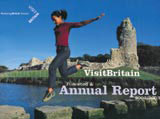Design key to attracting visitors to more of the UK

Tourist destinations in the UK need to put themselves on the map by becoming more ‘experiential and emotive’, the sector authority Visit Britain claims this week, pointing to the increasingly important role of design and branding in promoting visitor attractions.
Visit Britain’s annual report, designed by Redhouse Lane, shows the country has slipped from fifth to seventh in the world tourism earnings league. Setting its sights on recapturing fifth place, Visit Britain wants to see the UK regions pulling their weight.
Although Scotland has a ‘strong’ brand identity overseas, England and Wales are far less distinct in the minds of foreign tourists, says a Visit Britain spokesman.
‘Wales is often considered as part of England,’ he says. ‘And, of course, many Americans call the UK “England”. Smaller brands [like those developed by regional development agencies] don’t work so well with external audiences. Some are stronger than others – the English Riveria, for example, is appreciated by domestic tourists, but not really understood overseas.’
Citigate Lloyd Northover director Jim Bodoh, who has worked on promotional marques for Welsh food (DW 14 August), thinks Britain’s ‘unique regional associations’ can be harnessed, provided the branding ‘pulls away from the standard clichés’.
‘With our Wales work, we wanted to get as far away from the Middle Earth, Eisteddfod and druids positioning as possible, by focusing on things that reflect contemporary realities,’ he says. ‘The average person overseas, when asked to think of Welsh food, asks “What is Welsh?”.’
Bodoh maintains that it’s vital to promote ‘distinctive elements’ and specific attractions, not to market Britain as an ‘amorphous brand’ with a ‘generalised, olde worlde image’.
The majority of foreign tourists still shuttle between London, Edinburgh and Stratford-on-Avon. But Visit Britain, working with Corporate Edge on developing the Britain Brand overseas, is keen to highlight cities and regions not normally on the tourist trail.
The organisation is calling for tourism income to rise from its current level of £76bn to £100bn by 2010, with the contribution from venues and attractions outside London increasing from 46 per cent to nearly 60 per cent.
Particular emphasis is going on places to have benefited from National Lottery projects or regeneration initiatives, like Rotherham’s Magna Centre or Gateshead’s Baltic Centre. Visit Britain is developing more nuanced lifestyle segmentation, says the spokesman, designed to appeal to people’s interests.
It’s right to tap into ‘the power of the real’, says Land Design Studio creative director Peter Higgins, with ‘immersive’ attractions that visitors can experience together.
‘As designers, we have to create experiences that aren’t available elsewhere – in real time with real people in real places,’ he adds. ‘Where there are real objects, we need to bring them to life in interactive ways – unlocking the glass case through digitalisation.’
Radford Wallis creative director Stuart Radford agrees it’s often a question of finding new ways to package historical information.
The group’s work for the National Maritime Museum’s PortCities initiative involved developing a main theme that could link together five similar, but diverse cities (DW 16 October). ‘The porthole icon we created gives each city the flexibility to express its own story, while being tied in under the PortCities umbrella,’ he says. ‘They’re stronger for being part of a modern, engaging brand.’
-
Post a comment




